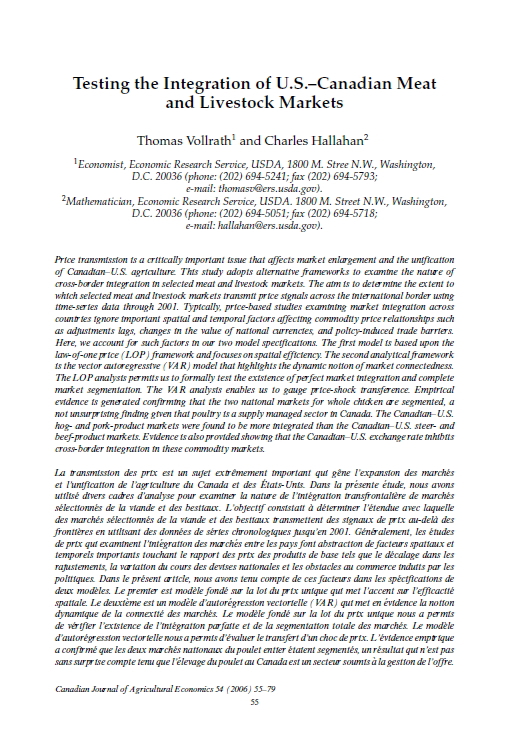Testing the Integration of U.S.-Canadian Meat and Livestock Markets
Title
Testing the Integration of U.S.-Canadian Meat and Livestock Markets
Date
Subject
Excerpt
Price transmission is a critically important issue that affects market enlargement and the unification of Canadian-U.S. agriculture. This study adopts alternative frameworks to examine the nature of cross-border integration in selected meat and livestock markets. The aim is to determine the extent to which selected meat and livestock markets transmit price signals across the international border using time-series data through 2001. Typically, price-based studies examining market integration across countries ignore important spatial and temporal factors affecting commodity price relationships such as adjustments lags, changes in the value of national currencies, and policy-induced trade barriers. Here, we account for such factors in our two model specifications. The first model is based upon the law-of-one price (LOP) framework and focuses on spatial efficiency. The second analytical framework is the vector autoregressive (VAR) model that highlights the dynamic notion of market connectedness. The LOP analysis permits us to formally test the existence of perfect market integration and complete market segmentation. The VAR analysis enables us to gauge price-shock transference. Empirical evidence is generated confirming that the two national markets for whole chicken are segmented, a not unsurprising finding given that poultry is a supply managed sector in Canada. The Canadian-U.S. hog- and pork-product markets were found to be more integrated than the Canadian-U.S. steer- and beef-product markets. Evidence is also provided showing that the Canadian-U.S. exchange rate inhibits cross-border integration in these commodity markets.
Relation
Canadian Journal of Agricultural Economics
Volume 54, Number 1
pp. 55-79
 An official website of the United States government.
An official website of the United States government.


